
Here is how to find companies that need websites:
- Conduct market research
- Analyze a business’ online presence
- Explore on social media
- Check local business directories and listings
- Leverage your network for referrals
- Implement cold outreach
- Analyze competitors
- Offer free SEO audits to businesses
- Join digital marketing forums and communities
- Connect with small to medium-sized business owners in LinkedIn
To find local businesses that need a website, first choose an industry or sector you want to work with. Then, head over to Google Maps, Facebook, or a local directory and listing to find companies under the specific industry or sector in your area. Scroll through the results and find the businesses that don’t have a website. This should be easy as businesses with websites usually have a link to it. List down the contact details of all the businesses with no websites and you already have your qualified leads. Tristan Parker, an expert marketer and owner of Parker Digital Marketing, says that this is the method that works best for his agency.
Websites for local businesses are very important. This is because it offers a wider reach, more credibility, better customer support, and increased sales. One study found that a whopping 97% of people look for a local business online. Meanwhile, a Verisign survey saw 84% trust a local business with a website more than one that just has a social media page.
The indicators that a company might need a new or updated website include low ranking in the search engine, outdated design, poor user experience, slow loading, and lack of mobile responsiveness. FastSpring research shows that it only takes 0.05 seconds for visitors to make a judgment about a site. Moreover, a 2023 Forbes Advisory survey saw 9 out of 10 people say they avoid a business if they had a bad experience on its website. So besides finding companies with no websites, you can also take advantage of the businesses that do have websites but it isn’t optimized.
However, finding companies that need a website comes with a few challenges. For one, 71% of businesses already have a website. That means it may take a while before you can find potential clients. Another challenge is that a business owner with no website is usually very hesitant. The top responses you’ll get are, “I prefer to promote my business with word of mouth”, “We don’t sell online so a website won’t get us any business”, “I’ll make my own website when I have time”, “I can’t justify the expense of building a website”, etc…
In this article, we’re going to look at other strategies to find companies that need a website. We’ll also provide some steps on how to build a strong relationship so that your leads can become clients. Finally, we’ll dive deeper into spotting websites that need optimization.
How to Find Businesses That Need a Website
1. Conduct Market Research to Identify Companies that Need Websites
Conducting market research involves searching the industries or sectors that are less likely to be digitalized. This way, it will be much easier to find companies that need a site. Now, to conduct market research, you can follow several methods:
According to a McKinsey and HBR report, the least digitalized industries are agriculture, construction, and healthcare. You’ll also find that small local businesses, specialized markets, or companies that have been around for a long time may not have websites. These are the companies that you can target for your services.
2. Analyze a Business’ Online Presence to Find Companies with Unoptimized Websites
Analyzing a business’ online presence is for targeting companies that have a website but it isn’t great. This approach is for those who offer services that improve a website. One effective way to find these company websites is to do a Google search for businesses within your target industry. Go to the second, third, or even fourth page in the search results. The websites there are usually the ones that are not optimized. You can also use website analysis tools like Google PageSpeed Insights, SEMrush, or Ahrefs. To evaluate whether the website is optimized or not, you need to check for several things:
3. Explore on Social Media to Find Companies Without Websites
Exploring on social media is one of the more effective ways on how to find businesses without a website. This is because more small business owners prefer social media to websites as it’s easier to create and manage. Combined reports from Statista, Entrepreneur, Truelist, and more show that 93.79% of businesses have a social media page. So your list of potential customers can be even longer if you explore on social media. To do that, let’s follow expert marketer Tristan Parker’s proven method:
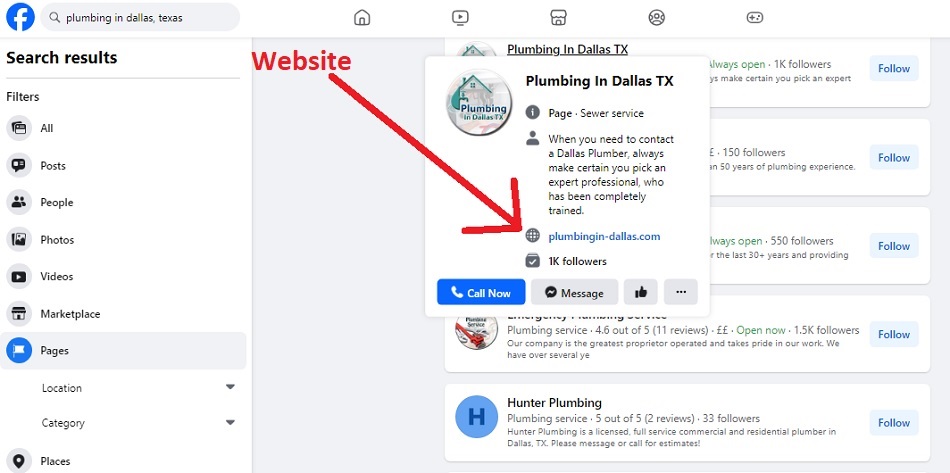
You can use the same method for Instagram, LinkedIn, and X. However, this may take longer as you’ll have to click on each individual page to see whether these companies have a website link or not.
4. Check Local Business Directories and Listings for Companies that Need Websites
Checking local business directories and listings is the best way to find companies that have zero online presence. In some platforms like Google Business Profile and Yelp, local businesses are automatically listed based on Google Maps or other sources. For this strategy, you can follow these steps:
The businesses that should have a website include retail stores, restaurants, professional services, home services, non-profit organizations, and real estate (Source: Pointersoft Technologies Pvt. Ltd). If you’re unsure what local business industries to search for, this list can give you a head start. It’ll also be easier to find potential clients in these industries. This is because they are the ones automatically listed on online directories and listings.
5. Leverage Your Network for Referrals Among Companies that Need Websites
Leveraging your network for referrals is one way to find companies that need websites without the Internet. If you already know people from local businesses, you can ask them if they or someone they know doesn’t have a website yet - and would like to have one. Or, you can go straight to business owners and simply ask them about websites. Now, you can’t just go straight to someone and have them trust you. This is why it’s a good idea to:
You might be thinking that this method is a bit outdated. It will take awhile before you can offer your services, too. However, it may be easier to turn someone into a client if you know them personally. There are many Reddit users who use this method and can vouch for it.
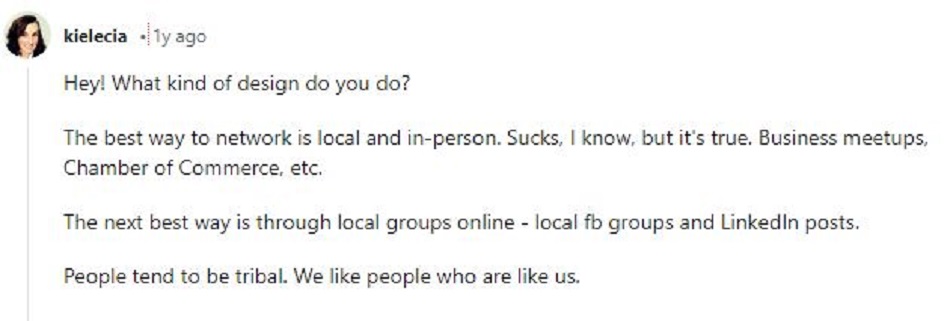

6. Implement Cold Outreach to Reach Companies Without Websites
Implementing cold outreach requires strategic planning as you’ll be offering your services right away. Remember, if you’re doing this strategy, one of the most important things is being an excellent talker. This is what will get the business owners' intrigue. In turn, they will genuinely consider your services. Here are the steps to finding businesses needing websites and offering your services:
Not every company needs a website. There are some businesses that have sufficient demand through other channels, such as word-of-mouth, social media, or local flyers and brochures. However, a website is essential if the business wants more credibility, leads, visibility, and sales. Through cold outreach, it’s your job to convince the business owners that they need a website, even though they’re okay without one.
7. Analyze Competitors to Find Companies that Need Optimized Websites
Analyzing competitors involves finding and listing companies within your target market. The aim here is to compare business websites and see which ones need better optimization. These are the potential clients that you’ll want to reach out to help them improve their site. To analyze competitors, here is what you can do:
8. Offer Free SEO Audit to Businesses that Need Better Websites
Offering free SEO audits is a great way to get business owners to come to you - instead of the other way around. But what’s an SEO audit? Well, it’s a comprehensive evaluation of a business’ website. You’ll assess its visibility and effectiveness in search engines based on technical SEO, on-page SEO, off-page SEO, and user experience. If a business owner is wondering why their website is not doing well, they will want to take advantage of your free SEO audit. If you’re doing this strategy, here is how it works:
However, some users from Reddit warn that doing an in-depth audit will take time. Moreover, some businesses just want to take advantage of the free offer with zero intention of getting your service. On the other hand, doing a free audit will prove to businesses that you know what you’re doing. This will make it easier for them to trust you and get your service. Here is how one Reddit user puts it:

9. Join Digital Marketing Forums and Communities to Find Businesses Without Websites
Joining digital marketing forums and communities will help you find businesses that need all types of web services. These platforms are where business owners, marketers, and web developers go to seek advice, solutions, and services. One downside is that you’re going to be competing with others that offer the same service as you. This is why you need to stand out. For that, you can:
The most popular digital marketing forums and communities are Warrior Forum, Digital Point, WickedFire, Reddit r/Entrepreneurship, Quora Specs, LinkedIn Groups, and local business networks and forums.
10. Connect With Small to Medium-Sized Business Owners on LinkedIn to See if They Need a Website
Connecting with small to medium-sized business owners on LinkedIn is a great strategy to find businesses that need websites. One TechReport survey found that small to medium-sized business owners think they have to grow bigger before creating a website. Meanwhile, a study by Codenest saw that 20% of small and medium business websites had weak designs. Also, LinkedIn makes it so easy to find these business owners. Here are some ways you can do that:
When you find these business owners, you can send them a personalized connection request. You can mention a specific detail from their profile or something you have in common. Or, you can just express genuine interest in their business. When you become connections, take some time to engage and help them before you go with your offer.
Reddit and Quora users agree that the best way to approach companies that need website and SEO improvements is to make an amazing website of your own and/or network with people. User Johnny Bamboo from Quora says that he created his own website to prove what he can do. He then went to different local businesses, showed them his website, and promised to give them the same. He now claims to have already created 400 websites.
11. Use Paid Advertising to Get Businesses Without a Website to You
Using paid advertising is a good way to bring potential clients to you. This eliminates the need to manually search for businesses that don’t have a website or need to improve it. If you make your ad hard to resist, then anyone who needs your services will immediately contact you. Now, if you’re doing paid advertising, the best kind is Google Ads and social media ads. According to HubSpot, the top 2 social media platforms that offer the highest return on investment (ROI) are Facebook and Instagram.
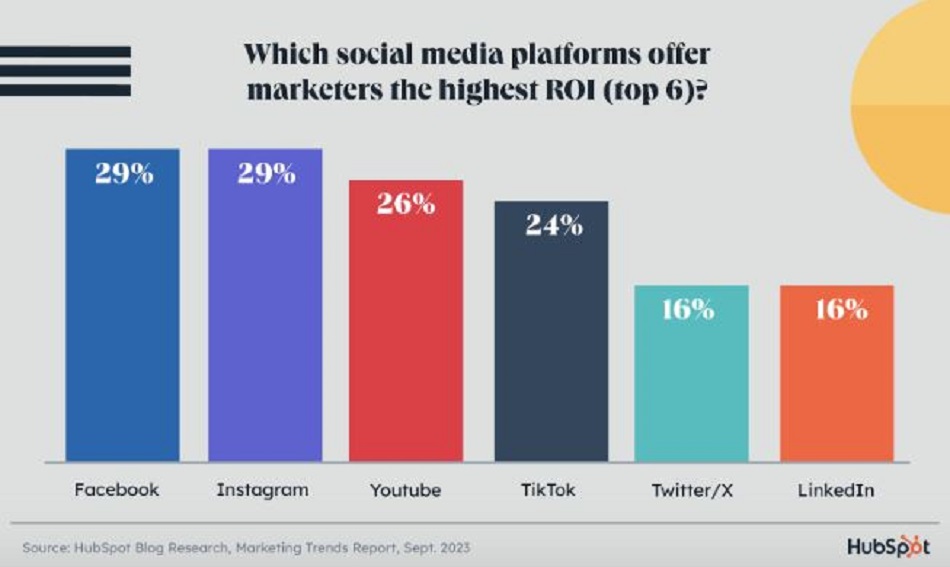
To make your ad stand out, you can follow these steps:
Margaret E, a Quora user, says that she built her own business website and promoted it through ad campaigns, on business platforms, social media channels, and local market places. With her strong online presence, many online business owners wanted her to help them boost their websites.
12. Maximize Content Marketing to Identify Businesses That Need Websites
Maximizing content marketing involves writing about the importance of a good website, how a website can benefit a business, etc... Most of the people that read these types of content are considering making or improving a website. You can then turn these readers into customers by ending your content with a call-to-action to contact you for more details. This strategy can also build trust and credibility. Just make sure to use relevant keywords and other local SEO strategies so that your content can be found by the target market. To go down this route, you can create content on:
Case studies - generates 73% of leads
Blog posts - generates 67% of leads
Social media posts - generates 66% of leads
Podcasts - generates 63% of leads
Educational videos, webinars, and online workshops - generates 20-40% of leads
Infographics - generates 12% of leads
Ebooks - generates 2.5-5% of leads
Email newsletters - generates 1-5% of leads
13. Use Website Analysis Tools to Find Businesses With Unoptimized Websites
Using website analysis tools is an easy way to check how websites are performing. When you see that it isn’t doing good, you can contact the owner and offer to help them improve it to rank higher in the Google SERP. To do this, follow these steps:
14. Review Sites and Feedback Platforms to Find Companies That Need to Improve Websites
Reviewing sites and feedback platforms will give you a good idea of which business websites are not performing well. In turn, you have the perfect leads to offer your website service. Here’s how to go about this strategy:
7 Essential Steps for Building Strong B2B Relationships
Here are 7 essential steps for strong relationships:
Provide valuable service
Build personal connections
Cultivate trust
Ask for feedback
Serve as a reliable support
Handle disagreements calmly
Go the extra mile
Now that you have a list of companies that need websites, it’s time to offer your website services. But instead of barging into their DMs asking to create or improve their websites, it’s better to build a strong relationship first. This way, you’re more likely to turn your leads into clients. A Novoresume survey saw a whopping 80% of clients make decisions based on the experience they have with someone offering a service.
Building Strong B2B Relationships Step 1: Provide Valuable Service
Providing valuable service will mean you understand the potential client’s needs. This is why it’s a good idea to check if the business needs a website created or optimized. For example, if you offer website creation services, then what you’re offering won’t be valuable to a business that already has a website. This way, you’re not wasting your time with people that don’t need your service. Valuable service is also important if you want them to stick around and maybe even recommend you to others.
Building Strong B2B Relationships Step 2: Build Personal Connections
Building personal connections will show that you’re not just in it for the money. No, you genuinely want to help the business grow. Adobe did a study and found that 79% of people say that they consider businesses that actually understand and care about them.
But where do you find connections? You’ll need to do some research. Try going to the business Facebook page or LinkedIn profile to see who the owner or manager is. Engage with them on these online platforms. If the business has no online presence, look for contact details in local directories or listings. Give them a call or send an email to set an appointment or a meeting to discuss their business and your services.Building Strong B2B Relationships Step 3: Cultivate Trust
Cultivating trust involves providing transparent communication. Be completely honest and open when you’re offering your services. This is so important as 73% of people say they’re willing to pay more for a product or service when there is total transparency (Source: Inc.). So explain exactly what your services include and what it does not. Give honest pricing by breaking down the cost of each part of your service. Offer realistic timelines and explain the factors behind them. Other things you can do to cultivate trust is provide case studies and your portfolio, address questions and concerns, and make a legal contract.
Building Strong B2B Relationships Step 4: Ask for Feedback
Asking for feedback from clients is crucial for continuous improvement, client satisfaction, and sometimes, for winning repeat business or referrals. Now, asking for feedback is a whole strategy in itself. You’ll have to ask for it at the right time - preferably when you’ve completed the project and enough time has passed for them to form an opinion. You’ll also have to ask direct questions instead of just “How did I do?” Then, you need to provide a channel where they input their thoughts. Some clients prefer completing an anonymous online survey. Other clients may want a personal phone call or face-to-face meeting. But the most important thing of all is to work on the feedback you get to make your services even better.
Building Strong B2B Relationships Step 5: Serve as a Reliable Support
Serving as a reliable support can enhance customer satisfaction and loyalty. This means that you’ll be communicating with your client throughout the project. Let them know exactly what you’re doing and how the project is going. But you need to do more than that. It’s a good idea to provide support even after the project. Ask them from time to time how the website is doing. With this kind of relationship, they will be very willing to do business with you again or recommend you to others. One ZDNet research found that 88% of people say that customer support is as important as the service provided.
Building Strong B2B Relationships Step 6: Handle Disagreements Calmly
Handling disagreements calmly is good practice to keep the relationship with your clients. You have to understand that not everything is going to go smoothly. There can be disagreements during the initial discussions, during the project, or even after it. If this is the case, you need to focus on the facts and not personal opinions. Make sure that you carefully listen to your client’s side, too. Since this is their business, they have every reason to have some worries. Of course, you need to be mindful of your language and body language as you discuss these disagreements. According to Hubspot, 16% of clients leave a service because of poor conflict management.
Building Strong B2B Relationships Step 7: Go the Extra Mile
Going the extra mile involves offering more than what the customer expects. For example, instead of just creating or improving a website, you can also offer training sessions. Teach them the basics of SEO, content marketing, and analytics. This way, your clients can manage their websites and understand traffic patterns on their own. You can also do a website performance check. After the website has been live for a month, offer to give them a detailed performance review of how it’s doing. This strategy will increase client satisfaction even more. They will be willing to do business with you again or tell others that you’re the best option for web creation or development services.
Top 5 Indicators That a Company Might Need a New or Updated Website
If you're offering website improvement services, it's crucial to know which websites are in dire need of an update. Here are some things to consider...
1. Decrease in Website Traffic Shows That the Website Needs Updates
A decrease in website traffic is easy to spot. Free tools like SimilarWeb, Alexa, SEMrush, and Ahrefs can help you check this. If a website’s traffic starts to dip, that could be because of a Google algorithm update, SEO issues, changes in consumer behavior, or improved competition. What do these have in common? A website update can fix the issue. Clayton, WebFX’s internet marketing expert says that taking time to update content and SEO can go a long way in boosting a site back up.
2. Website Content That Doesn’t Deliver the Right Message Needs an Update
Website content that doesn't deliver the right message is a sure sign that the website needs some serious updates. In 2022, Google implemented a ‘Helpful Content Update’. With this, they prioritized websites that bring valuable content to the readers. So go through your list of companies that need optimized websites and read through their content. If it isn’t helpful or doesn’t deliver the promised message, you know that it needs to be updated.
3. Unresponsive Website Design Requires an Update
Unresponsive website design causes 73.1% of visitors to exit a website, according to a Good Firms study. To check if a website design is unresponsive, simply access it with various devices. If the layout is good on big screens but poor on smaller ones, you’ll know that it needs to be optimized for mobile use.
4. High Bounce Rates Indicate Website Update Needs
High bounce rates mean that visitors go in and out of the website without spending time on it. This tells Google that it isn’t a good website, thus lowering its rank on the SERP. The SEMrush team says that a bounce rate of 60% is already an indicator that a website needs to be fixed. However, you can’t view a website’s bounce rate without access to the dashboard. So if you’re looking for who needs website updates, you may have to rely on competitive analysis tools. SimilarWeb or Alexa can give you an overview of a website’s engagement metrics, such as visit duration and pages per visit. This can indirectly tell you about bounce tendencies.
5. Security Issues Requires Website Updates
Security issues make a website unreliable and so keep people away. A USA Today report predicts that cybercrime will cost a shocking $9.5 trillion in 2024. This is why cybersecurity is so crucial today. Now, you can spot security issues as modern browsers warn you if they suspect the website is unsafe. More than that, websites without an HTTP URL means it doesn’t have an SSL certificate. You can also use free website scanner tools, such as Sucuri SiteCheck, Google Safe Browsing, and VirusTotal, to report security issues.
How Long Does It Take to Design and Develop a Custom Small Business Website?
It takes 2-8 weeks to 3-6 months to design and develop a custom small business website. If you already know how to use the website creation tools, then it can take as short as 2 to 8 weeks, depending on the web design. However, if you’re still a beginner, expect it to take longer than a month to get a website up and running. This is because you have to watch many training videos, go through trial and error, and all that. Just know that the more you do it, the easier it becomes.
You can also utilize AI tools to help quicken the process. For example, the Wix AI Website Builder can create a website from scratch. All you need to do is tell it your business and the website goals. Adobe Express offers a variety of AI website design templates and tools that can create graphics, videos, and more. ChatGPT can help you create content for your pages, too. A Nestify report says that a website built with AI assistance can reduce the development time by 50%.
How Much Are Small Businesses Willing to Pay for a Website?
Small businesses are willing to pay $500 to $5,000 for a website. Of course, the actual pricing will depend on the complexity of the site. Ander Silva, the lead web developer at vermic.com and educativapps.com, says that ecommerce sites usually start at $500. He goes on to say that small to medium-sized businesses are willing to pay an average of $800. But if they want a fully customized website, they will be willing to cash out $5,000+. Here’s what one Quora user has to say:
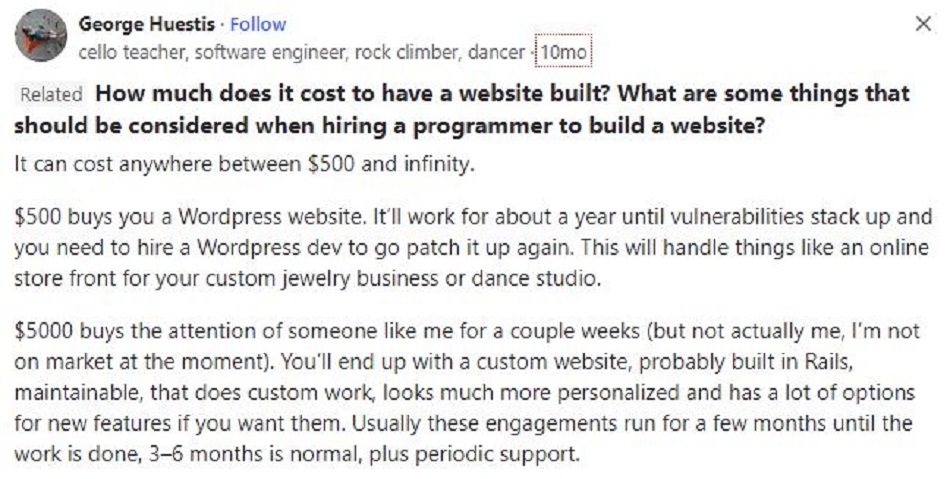
However, one important information is that there are some freelance web developers that are offering to build a website for as little as $5-$30. But that’s usually just the homepage and/or a few other pages. To attract clients to you, it’s best to market yourself as a professional service that can offer more than that. This will justify your ask for $500 or more to build or improve a business website.
When giving your price, there are a few things you need to consider. This includes the website creation costs, your skill level and experience, market rates, project complexity, and cost of doing business. If you calculate everything together, you’ll have an estimate of how much you should charge for the service you’re offering a client.
Are Rank and Rent Websites Profitable?
Yes, rank and rent websites are profitable as one website can generate $500 to $3,000 every month. If you’re able to rent out 16 websites, you can earn a streamlined monthly revenue of $50,000! Plus, you don’t even need to spend that much to make a website and rank it. To create an optimized website, you may spend anywhere between $25 to $300. It doesn’t cost anything to rank a website if you use SEO strategies to get organic traffic. So you’ll be spending little and earning much with rank to rent websites.
Why Rank and Rent Is the Best Option When Creating Websites
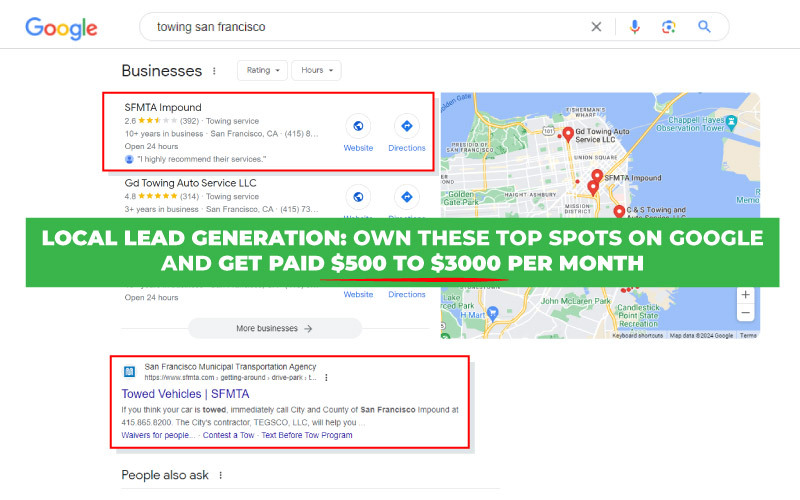
Rank and rent is the best option when creating websites because of the consistent monthly income stream. With this business model, you create a website for a specific local business industry, use SEO strategies to rank it, and rent it to a local business in the same industry. This is great for two reasons. The first one is that you’re only renting the website out, so you’ll earn every month. Also, since the website is already ranking, any local business without a website will be willing to pay a lot for it.
As an experienced web developer, you can earn $50,000+ for a website creation. But that will only be a one-time payment for each client. Also, web developers are struggling a bit as there are now AI tools and free website templates that help small businesses create their own websites. Meanwhile, big companies usually hire an in-house marketing agency to deal with website updates. To sell websites effectively, you must first find the companies in need of a website or website optimization. From there, you'll need to build a relationship with the business owner and convince them that your service is what they need to increase brand visibility and sales.
If you don't want to go through all that, try local lead generation. You can earn $50,000 every month! This is because you're not actually selling the website, but renting it out. Plus, you don’t even need a name for yourself as you’re already offering a website with a strong online presence. And I speak from experience. I now earn the promised $50,000 every month.
Since local lead generation targets small local businesses, you will face less competition compared to broader, national markets. You also don’t have to do much work since the website will generate leads by itself. One study found that 75% of website clicks go to the top 5 websites that are ranking on Google SERP. Local lead generation is one of the easiest and most profitable business models to start.



